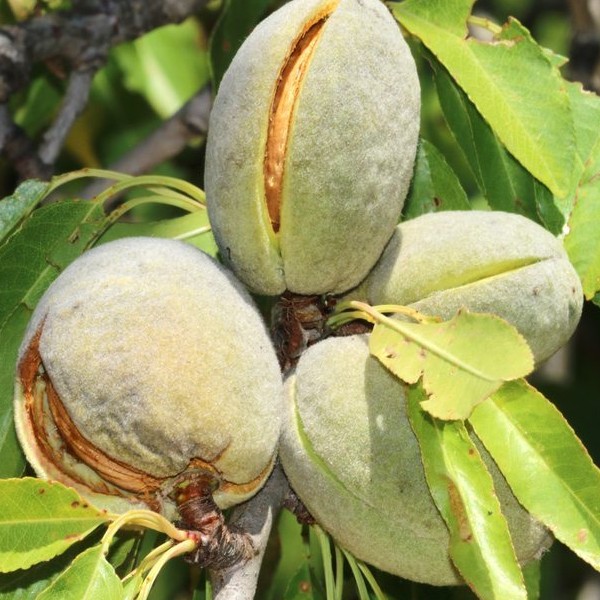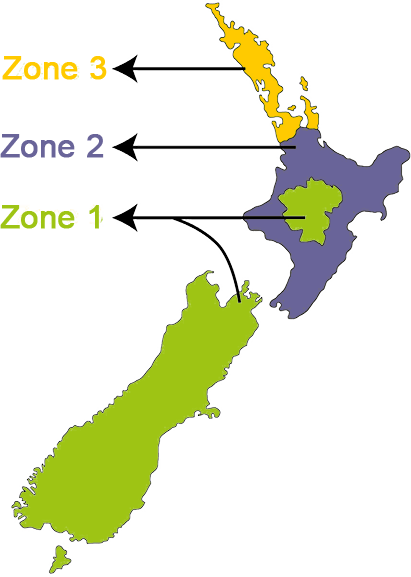
Growing Guide
Almonds produce better on light types of soil, as their roots don’t tolerate wet soils. Well drained loamy soils are best with pH 6-7. Choose a sunny location. Trees need 180-240 growing days to mature the crop. There is the need for mild weather over flowering so the bees can work. Almonds are hardy to –7°C, but actually seem hardier than this in New Zealand. They need winter chilling of 300-600hrs below 7°C (depending on cultivar) to break dormancy and mature the buds. The blossoms and young fruit can be killed by –1°C degree frost. Trees can grow to 6-9m tall. They are one of earliest trees to flower. Taken from https://treecrops.org.nz/crops/nut/almond/almond-factsheet/
3cm
50
120
1825
1825
Fill a container with tap water and put at least a dozen almonds into it.
Allow them to soak for at least 8 hours and then drain them.
Why so many nuts if you only want one tree? Because of their uncertain germination rate.
Using a nutcracker, partially crack the almond shell to expose the interior nut.
Don’t remove the shell.
Arrange the nuts in a container lined with damp paper towel or sphagnum moss and cover the container with plastic wrap to retain moisture.
Place the container of nuts into the refrigerator for 2-3 months, checking each week to be sure is still moist inside.
This process is called stratification.
Once the seeds have been stratified, fill a container with potting soil.
Press each seed down into the soil and inch (2.5 cm.) or so.
Water the seeds and place the container in a warm, sunny area.
Water once a week or when the soil feels dry 1 ½ inches (4 cm.) down into the soil.
Transplant the plants when they are 18 inches (46 cm.) in height
They thrive in mild, wet winters and hot, dry summers in full sun.
If your region doesn’t fall within these parameters, it’s unlikely an almond tree will set fruit for you.
Very few varieties of almond tree are self fertile, and therefore need cross pollination for fruit production, so you’ll need to plant at least two trees.
If space is at a premium, you can even plant two in the same hole, wherein the trees will grow together and intertwine, allowing the flowers to cross pollinate.
Try All-in-One for a self fertile, popular variety.
Almonds can be grown in large pots or planter boxes, but look for dwarf, self-pollinating/fertile forms such as 'All In One'.
Choose a pot at least 600mm wide.
Almond trees are deep rooted and should be planted in deep, fertile, and well-draining sandy loam.
Almond trees should be planted 19 to 26 feet (6-8 m.) apart and irrigated despite the fact that the trees are drought tolerant.
An application of nitrogen and organic fertilizer will aid in growth.
These trees have high nitrogen (N) and phosphorus (P) requirements.
During the spring bloom season, care of almond trees should include fertilization of mature trees with urea or manure, watered in or small doses of nitrogen for young trees.
Drip irrigation should be initiated daily for those newly planted, with the trees needing at least 2 to 3 inches (5-8 cm.) of water.
Established trees can get by on 2 to 3 inches (5-8 cm.) of weekly watering in the absence of rain and may require additional watering during times of drought.
Also, if the tree is planted in shallow or sandy soil, it will need more water.
During the summer, continue to irrigate and fertilize at the same rate as the spring application up until harvest.
The harvesting of almond tree fruit occurs after the hulls split and the shell becomes dry and brown in color.
Almonds need 180 to 240 days for nuts to mature wherein the nut (embryo and shell) has dried to minimum moisture content.
To harvest the almonds, shake the tree, then separate the hulls from the nut.
Freeze your almond nuts for one to two weeks to kill any residual worms and then store in plastic bags.
To harvest the almonds, shake the tree, then separate the hulls from the nut.

Zone 1 - Cool
August , September
Zone 2 - Temperate
August , September
Zone 3 - Subtropical
May , June , July , August , September
Pests
Problems